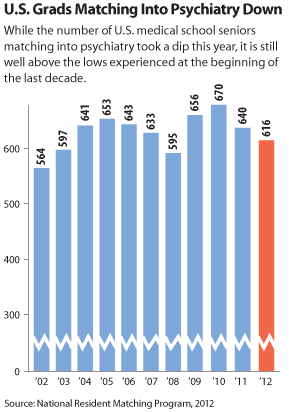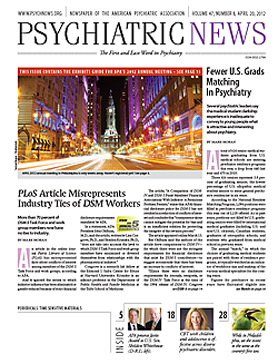A total of 616 senior medical students graduating from U.S. medical schools are entering psychiatry residency programs this year, a drop from 640 last year and 670 in 2010.
Those 616 seniors represent 3.9 percent of graduating seniors, the lowest percentage of U.S. allopathic medical student seniors to enter general psychiatry residencies in six years.
According to the National Resident Matching Program, 1,096 positions were filled in psychiatry residency programs this year out of 1,118 offered. As in past years, positions not filled by U.S. graduating seniors were filled by international medical graduates (including U.S. and non-U.S. citizens), Canadian students, graduates of osteopathic schools, and students who graduated from medical school in previous years.
The annual “match,” in which the choices of graduating medical students are paired with those of residency programs, is typically watched as an indicator of workforce size and makeup of the various medical specialties for the coming years.
Figures for psychiatry in recent years have fluctuated slightly (see chart), but the downward trend and the fall-off this year have some psychiatric leaders and educators concerned about psychiatry’s professional identity and how it is being presented to young medical students. Several leaders have emphasized especially that the clerkship experience that medical students receive in psychiatry is inadequate to convey what is attractive about practicing the profession.
“We need to reach out to medical students in more effective ways than simply exposing them to a four-week clerkship on an inpatient unit, with no follow-up of the patients they have cared for,” said APA President John Oldham, M.D. “Establishing and maintaining ongoing relationships with patients is one of the key factors that make psychiatry such a fulfilling career.”
Oldham said that students need to get a taste of what it is like to get to know their patients and follow their progress over time, especially now, when psychiatric treatments are more effective than ever.
Oldham’s remarks about clerkships were echoed by Sidney Weissman, M.D., a past APA trustee and past president of the American Association of Directors of Psychiatric Residency Training (AADPRT), who has maintained a long-time interest in workforce issues. “I am sure that a four-week clerkship on an inpatient unit where patients are medicated and discharged in a week, where neither the resident nor student has any follow up on the patient is not an effective learning experience for our discipline,” he said. (For reactions from other AADPRT leaders and members, see
What’s Deterring Med Students From Psychiatry Careers.)
Weissman has been concerned about how psychiatry defines and presents itself. “The picture of contemporary psychiatry is confusing to many of us and must be more confusing to our students,” he said. “Until we restore clarity to what our discipline is and develop creative ways to communicate it in a few weeks of psychiatric clerkship to our medical students, I am concerned that recruitment will continue to decline.”
In a press release responding to the match results, APA Medical Director James H. Scully Jr., M.D., noted that there are currently about 50,000 psychiatrists in the United States, a number that is already inadequate to serve all the patients who need help, especially those in rural areas of the country. According to the National Institute of Mental Health, there are more than 3,500 Health Professional Shortage Areas for Mental Health, mostly in nonmetropolitan areas.

Comprehensive statistics on this year’s match are posted at www.nrmp.org . 
